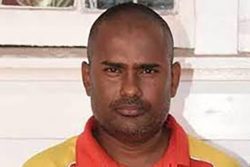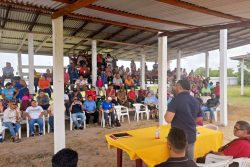The Steering Committee on Constitutional Reform (SCCR) sees the completion of the entire process within 18 months and it has recommended a reduction of immunities for the President, limiting the powers to prorogue or dissolve Parliament and excluding the Attorney General from Cabinet so the holder of that office remains unbiased and impartial.
Presented to Prime Minister Moses Nagamootoo on Saturday, the timeframe envisioned by the SCCR means that the next Local Government Elections due in just under three years could be held under a reformed constitution.
The SCCR which was appointed by the Prime Minister comprised C A Nigel Hughes, Professor Harold Lutchman, Haslyn Parris (who passed away recently), Gino Persaud and Geeta Chandan-Edmond.
A three-tiered reform system has been recommended by the SCCR where a group of legal experts on the Constitution Reform Commission (CRC) will prepare a draft document encompassing some of the SCCR’s recommendations. This will then be distributed to stakeholders including representatives of political parties and civil society. The CRC will then be expanded to include representatives of political parties and civil society. The expanded CRC will then deliberate on submissions received and prepare a report which is to be perfected by its legal experts. This report will then be taken to the National Assembly for debate after which a referendum or some other method would be employed for the prospective adopting of the recommendations.
After receiving numerous recommendations from constitutional and legal experts and others, the SCCR set out its proposals.
It said that the constitutional immunities of the President should be considered for reduction and the President’s powers to prorogue or dissolve Parliament should be considered for amendment particularly in relation to “restricting the exercise of this power in limited defined circumstances.” Former President Donald Ramotar’s proroguing of Parliament in 2015 to avoid a no-confidence motion piloted by the Alliance for Change had raised questions about these powers and the conditions under which they could be exercised.
The SSCR further recommended that the Attorney-General (AG) should be excluded from membership of Cabinet so that the holder could “remain unbiased and impartial in his advice” to the government. However, the AG could still be invited to attend and participate in Cabinet proceedings as is the case in the UK.
Also recommended by the SCCR was that Article 1 of the Constitution be amended to remove the word “Co-operative” so that the country would be described as the Republic of Guyana. Consideration should also be given for the National Assembly to be expressly vested with the authority to “amend and vary estimates presented by the Minister of Finance or other competent and authorized (members) of the National Assembly. Reference was made by the SCCR to the decision in the court matter of the Attorney General V Raphael Trotman after APNU+AFC, while in opposition, had cut budgetary allocations and the then ruling PPP/C moved to court in a bid to reverse these.
The SCCR proposed a list of representatives who would sit on the CRC after the base document was prepared by legal experts. The expanded membership would comprise one representative each from A Partnership for National Unity, the Alliance for Change, the PPP/C, trade unions, organisations representative of youth in Guyana, the Guyana Bar Association, the Indian Action Committee, the indigenous peoples, the African Cultural Development Association, the Christian community, the Hindu community and the Islamic community.
The SCCR said that the representatives from each of the non-party political groups are to be appointed by the respective organisations after a “verifiable electoral process determined by the National Assembly or a select committee thereof.”
Methodology
On the methodology for the submission of recommendations, the SCCR said that the CRC should consider the hiring of a public relations team which would be responsible for disseminating information on its work to the public including submissions received. The SCCR also recommended public hearings and written submissions.
Included in its terms of reference was the identification of experts who could be part of the reform process. Among those recommended were Fenton Ramsahoye SC, Sir Shridath Ramphal, Miles Fitzpatrick SC, Rex McKay SC, Ralph Ramkarran SC, Dr Bertie Ramcharan, Professor Duke Pollard, Dr Nigel Harris, Dr Thomas Singh and South African justice Albert Louis Sachs.
Model constitutions proposed by the SCCR for study were those from Canada, India, South Africa, Fiji and Singapore.
In its consideration of the proposals that were received from various stakeholders, the SCCR said it is of the view that Article 40 of the constitution which deals with the fundamental rights and freedoms of an individual has become so wide since the last round of amendments that judges sometimes overlooked the full import of the article when addressing enforcement issues of the fundamental rights as set out in Articles 139 to 151. It said that one of the potential consequences was that where there were no specific enforcement provisions for the expanded rights in Article 40, litigants were denied the recognition and enforcement of the article. The SCCR said it is proposed that Article 40 and the enforcement provisions be located in the same section of the constitution.
The SCCR further said that it has noted that several government functions have been given out over the years to quasi autonomous bodies with the attendant erosion of the protections guaranteed by the constitution not being made available to citizens affected by the actions of these bodies.
On the question of the death penalty, the SCCR said it was of the view that particular attention should be paid to the test utilized in India of only in the rarest of cases.
Among the terms of reference of the SCCR were the following: outline a process and a methodology by which constitutional reform can be achieved, identify the scope of constitutional reform that is necessary for more inclusive, democratic and transparent governance and identify amendments and inclusions that may be needed to ensure that the executive can be held accountable.
Receiving the report on Saturday, Nagamootoo said “We hope that the guidance contained in this report, which is the final report, would be able to give us both enough time and space in which we could achieve the… [changes] in our constitution.
“Today, I am going to try to read this and see what I would be able to do to take it forward, first to the Cabinet and then we would announce the further stages in the process.”
The work of the SCCR began on September 1, 2015 and was to be concluded by December 31, 2015. The committee was unable to meet that deadline and an interim report was issued prior to Saturday’s presentation of the final report.
The last round of constitution reform occurred in 2001 and culminated a process that began in 1999.









